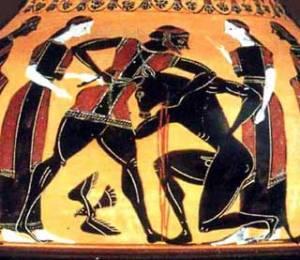Cretan History
Crete, the island with a most intriguing history in both ancient and modern times.
 The famous spearsman Idomeneus led the Cretans, who held Cnossus, and the well-walled city of Gortys; Lyctus also, Miletus and Lycastus that lies upon the chalk; the populous towns of Phaestus and Rhytium, with the other peoples that dwelt in the hundred cities of Crete. All these were led by Idomeneus, and by Meriones, peer of murderous Mars. And with these there came eighty ships. The famous spearsman Idomeneus led the Cretans, who held Cnossus, and the well-walled city of Gortys; Lyctus also, Miletus and Lycastus that lies upon the chalk; the populous towns of Phaestus and Rhytium, with the other peoples that dwelt in the hundred cities of Crete. All these were led by Idomeneus, and by Meriones, peer of murderous Mars. And with these there came eighty ships.
(Homer's Iliad; Written 800 B.C.E. Rhapsody B' : The Catalogue Of Ships - Translated by Samuel Butler)
The island with a most intriguing history in both ancient and modern times. After the destruction of the Minoan Civilization and ruling, it underwent over three millennia of occupation by various forces. First were the Mycaeans from the mainland (1400-1100 BC), then came the Dorians, also from the mainland (1100-67 BC). The Romans took over in 67 BC. When Rome's power declined at the end of the 4th century AD, Crete became part of the Byzantine Empire and was ruled from Constantinople (Istanbul). The Arabs conquered Crete in around 824; the Byzantines came back in 960, but had to sell it to the Venetians in 1204, to secure their rule over their newly re-conquered capital city, Constantinople; it fell to the Turks in 1669 and became part of the Ottoman empire.

In 1898, as a result of continuous revolts against the Turkish occupation, the Turks were removed from Crete, which eventually came under the rule of an international administration. Greece and, in particular, the world powers of the time resisted Crete's desire to be unified with Greece until 1913. It was then that Eleftherios Venizelos, a Cretan politician, was appointed Prime Minister of Greece, and decided in favor of Crete’s unification with the rest of liberated Greece, and managed to diplomatically make this decision go through.
So, after nearly 300 years under the Turks, in 1913 the Greek flag was hoisted in Firkas Fortress in Chania, and Crete was annexed to Hellas. In 1941 the Germans tried hard to control Crete, and they eventually managed to it, but only after they had lost the very best of their commando forces and six months of precious time. How disastrous was this delay became apparent when their attack against Russia stranded their troops in the mud amidst the heavy Russian winter. |
|



